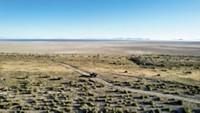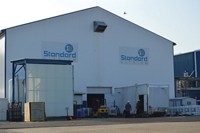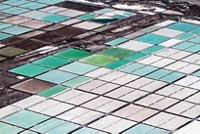Advertisement
Grab your lab coat. Let's get started
Welcome!
Welcome!
Create an account below to get 6 C&EN articles per month, receive newsletters and more - all free.
It seems this is your first time logging in online. Please enter the following information to continue.
As an ACS member you automatically get access to this site. All we need is few more details to create your reading experience.
Not you? Sign in with a different account.
Not you? Sign in with a different account.
ERROR 1
ERROR 1
ERROR 2
ERROR 2
ERROR 2
ERROR 2
ERROR 2
Password and Confirm password must match.
If you have an ACS member number, please enter it here so we can link this account to your membership. (optional)
ERROR 2
ACS values your privacy. By submitting your information, you are gaining access to C&EN and subscribing to our weekly newsletter. We use the information you provide to make your reading experience better, and we will never sell your data to third party members.
Energy Storage
Lithium firms hope direct extraction will boost production in Chile
But it will take years to build desalinated water infrastructure to feed the process
by Matt Blois
December 28, 2022

The mining companies Albemarle and SQM have laid out yearslong plans to bring desalinated seawater to their lithium operations in Chile’s Salar de Atacama so they can introduce direct lithium extraction (DLE), an emerging technology that has the potential to boost production for the rapidly expanding electric vehicle battery market.
DLE technologies use adsorbents, solvents, membranes, or ion-exchange materials to separate lithium from salty brines. Firms then reinject the spent brine back into the aquifer where it came from.
Companies developing DLE claim the techniques can extract upwards of 80% of a brine’s lithium, compared to roughly 40-65% extracted by existing methods that concentrate brine in evaporation ponds. Researchers have been working on DLE techniques for decades, but very few projects have moved past demonstration scale.
Using the technology in Chile would be an especially difficult challenge. DLE typically requires large amounts of water, which is in short supply in Chile’s arid salt flats. The process would also require bringing lots of electricity to a relatively remote area. And it’s not yet clear how reinjecting spent brine would impact the Salar de Atacama.
“There’s still a big technological question,” says Daniel Jimenez, president of the lithium consultancy iLiMarkets. “They need to prove themselves.”
In a step toward implementing DLE, Albemarle agreed in the fall to buy freshwater for the Salar de Atacama from the engineering firm Cramsa, which is building a desalination plant near Antofagasta, Chile, and a pipeline that will supply water for communities and industrial projects across the region. The pipeline is already slated to reach a copper mine about 50 km from the Salar de Atacama.
Albemarle would need other copper or lithium miners nearby to buy water from the project to justify extending the pipeline to the area, according to Ignacio Mehech Castellón, Albemarle’s country manager in Chile. The company wouldn’t have access to the water until at least 2027.
“If [Cramsa] manages to get enough demand from the Salar de Atacama, they will get there,” Mehech Castellón says. “If they get there, they will offer water to the communities as well.”
Albemarle would use the water to operate a DLE process. The company hasn’t disclosed which technology it plans to use but says it is considering both internally and externally developed processes. Mehech Castellón says Albemarle piloted one DLE technology in Chile in 2018 and expects to pilot several others in 2023.
In September, SQM announced that it plans to spend $1.5 billion on desalinated seawater, DLE, and other technologies to improve lithium production in Chile. If successful, the project would help increase lithium production capacity by more than 60% from 2021 levels, the company says.
SQM was already planning to build a pipeline to supply seawater to a new facility near Sierra Gorda, Chile, that will produce nitrates and iodine. The goal is to add a desalination plant and extend the pipeline 270 km further to supply freshwater for the Salar de Atacama.
Rather than using desalinated water for its own processes, like Albemarle would, SQM would provide nearby communities with enough freshwater water to offset any water consumed by lithium production, including water lost during evaporation.
SQM also wants to use DLE in a different way than Albemarle would. Under the firm’s plan, it would first pump brine into evaporation ponds and precipitate sodium chloride. Then a mechanical evaporator would remove water and the fertilizer potassium chloride, yielding a concentrated lithium brine. The DLE plant would use water from the mechanical evaporator to strip lithium from the concentrated brine, and the spent brine would be reinjected.
SQM is still evaluating DLE technologies. Stefan Debruyne, SQM’s external affairs director, says the company has already piloted four approaches and may pilot a few more. Debruyne says SQM is pursuing the multistep route rather than a direct DLE process in part because it wants to produce potassium chemicals, which account for 7% of the company’s profits.
Both companies’ DLE plans would have to overcome a number of technological and regulatory hurdles. SQM doesn’t expect to submit an environmental assessment of its project to Chilean regulators until the second half of 2024. “There are a lot of milestones that we have left,” Debruyne says. “It’s a very complex puzzle.”
Albemarle has asked regulators to approve a pilot project starting in early 2023 that will study the best way to reinject brine into the ground, according to Mehech Castellón. Albemarle currently reinjects brines from which it has extracted bromine in Arkansas, but the hydrogeology of the Chilean brine aquifer is distinct. “We would want to leverage that experience,” Mehech Castellón says of the Arkansas process, “but understanding that this is different.”
If successful, the new approach could open up big opportunities, Jimenez, the consultant, says. To minimize environmental impact, Chilean regulators limit how much brine SQM and Albemarle can extract, but if reinjection prevents brine levels from dropping, they could theoretically extract more. “That’s why DLE technologies, as a concept, are so attractive,” Jimenez says.
In 2020, SQM committed to cutting its brine extraction in half over the course of a decade. SQM will stick with that plan for now, but in September 2022 SQM CEO Ricardo Ramos said reinjection might allow the company to consider increasing extraction in the future. He said his dream is that processing more brine with DLE could eventually double the company’s lithium production. “It will depend on the balance, on the geological studies, and the hydrogeological equilibrium,” Ramos said.
In addition to getting DLE technology to work at scale, Jimenez says, a big question is how much it would cost to produce lithium in this way. The desalinated water and additional energy would be expensive, but Benchmark Mineral Intelligence reports that lithium prices rose by 150% in 2022. “At today’s price levels,” Jimenez says, “almost anything is economically reasonable.”





Join the conversation
Contact the reporter
Submit a Letter to the Editor for publication
Engage with us on Twitter